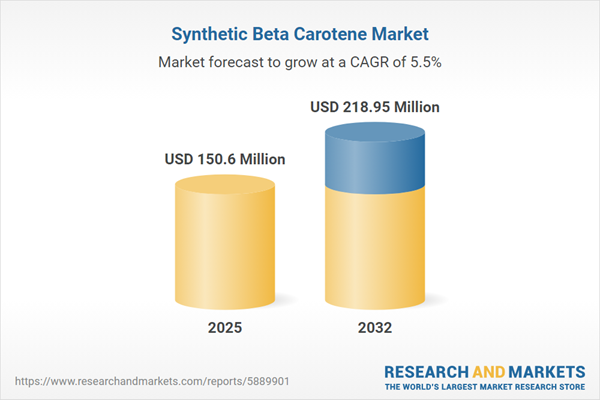Speak directly to the analyst to clarify any post sales queries you may have.
Senior decision-makers in the synthetic beta carotene market must navigate a rapidly changing landscape shaped by regulatory shifts, technology advances, and evolving customer expectations. Strategic flexibility and operational adaptability are essential for capitalizing on emerging opportunities as industry requirements become more complex.
Market Snapshot: Growth and Trends in the Synthetic Beta Carotene Market
The synthetic beta carotene market is valued at USD 142.91 million in 2024 and is projected to reach USD 218.95 million by 2032, marking a 5.47% compound annual growth rate. This anticipated expansion is attributed to durable demand from food and beverage, nutraceuticals, animal feed, cosmetics, and pharmaceutical industries. Producers are optimizing both advanced biotechnology and traditional chemical synthesis to enhance production agility. Forward-looking organizations are aligning with evolving regulatory requirements to secure cost efficiencies and boost response capability as global supply chains become more intricate. Those investing in innovative processes and responsive operations are positioned to achieve a distinct competitive advantage.
Scope & Segmentation: Strategic Dimensions for Synthetic Beta Carotene
- Applications: Synthetic beta carotene serves animal feed, aquaculture, poultry, ruminant, swine nutrition, cosmetics, functional foods and beverages, nutraceuticals, dietary supplements, and pharmaceuticals, each with unique compliance and customization needs.
- Product Forms: The compound is available in oil suspensions and powder formats, supporting flexible integration with diverse end-use manufacturing processes and fostering innovation across finished goods.
- Purity Grades: Cosmetic, feed, food, and pharmaceutical grades ensure suitability for stringent sector-specific requirements, maximizing quality and safety across distribution channels.
- Manufacturing Processes: Employing both biotechnological advancements and chemical synthesis, producers achieve scalable and cost-effective manufacturing while upholding environmental best practices and ensuring operational agility worldwide.
- Distribution Channels: Distribution strategies include direct sales and partnerships with strategic suppliers, enabling optimized access to market, efficient deliveries, and stronger supply chain stability.
- Regions Covered: The market footprint spans the Americas, Europe, Middle East, Africa, and Asia-Pacific. Regional expertise in compliance and local consumption patterns underpins successful market penetration and differentiation.
- Key Companies Profiled: Leading firms such as Koninklijke DSM N.V., BASF SE, Aditya Birla Chemicals, Jiangsu Sandoo Biotechnology, Zhejiang NHU, Roha Dyechem, Pylam Products Company, Nantong Julong Biotechnology, Ningbo Manson Imp. & Exp., and Toray Industries drive the market’s technological progress and shape strategic approaches.
Synthetic Beta Carotene Market – Key Takeaways for Senior Leadership
- Adoption of microbial fermentation and catalyst technologies enhances operational efficiency, raising the standard for adaptation and sustainability across the sector.
- Promoting transparency in sourcing and embedding agile compliance systems helps reinforce brand credibility and limit exposure to regulatory or reputational events.
- Deployment of digital solutions such as predictive maintenance and optimized scheduling delivers accuracy in supply chain management and demand forecasting.
- Forging alliances throughout the supply chain increases organizational flexibility, enabling leaders to respond rapidly to policy shifts and external disruptions.
- Commitment to ESG objectives, including circular economy practices and product lifecycle management, strengthens alignment with investor expectations and emerging regulations.
- Delivering tailored, high-purity formulations allows organizations to access premium segments in animal nutrition, health-centric foods, and personal care.
Tariff Impact: Navigating U.S. Trade Policy
Current U.S. tariff strategies are elevating cost pressures throughout the synthetic beta carotene supply network. Businesses are strengthening domestic supplier partnerships and diversifying sourcing to maintain operational stability. Enhanced internal processes and adoption of transparent pricing and long-term supply contracts are central to mitigating risks and maintaining reliable procurement in the shifting trade environment.
Methodology & Data Sources
The findings presented here are based on direct insights from senior executive interviews, analysis of local and international regulatory developments, collaboration with leading industry associations, and case study research. This approach ensures that all conclusions are highly relevant for executive strategy and planning.
Why This Synthetic Beta Carotene Market Report Matters
- Empowers leaders to address technological, regulatory, and operational changes, maintaining organizational agility and readiness.
- Delivers regional and strategic insights for navigating diverse regulatory environments and competitive dynamics.
- Provides actionable guidance to enhance operational resilience against evolving supply chain and compliance challenges.
Conclusion
This report offers actionable analysis and targeted recommendations to support sound leadership decisions in the synthetic beta carotene market. Executives gain the tools required to strengthen resilience and drive sustained organizational growth in a dynamic market environment.
Additional Product Information:
- Purchase of this report includes 1 year online access with quarterly updates.
- This report can be updated on request. Please contact our Customer Experience team using the Ask a Question widget on our website.
Table of Contents
3. Executive Summary
4. Market Overview
7. Cumulative Impact of Artificial Intelligence 2025
Companies Mentioned
The companies profiled in this Synthetic Beta Carotene market report include:- Koninklijke DSM N.V.
- BASF SE
- Aditya Birla Chemicals (India) Limited
- Jiangsu Sandoo Biotechnology Co., Ltd.
- Zhejiang NHU Co., Ltd.
- Roha Dyechem Private Limited
- Pylam Products Company, Inc.
- Nantong Julong Biotechnology Co., Ltd.
- Ningbo Manson Imp. & Exp. Co., Ltd.
- Toray Industries, Inc.
Table Information
| Report Attribute | Details |
|---|---|
| No. of Pages | 185 |
| Published | October 2025 |
| Forecast Period | 2025 - 2032 |
| Estimated Market Value ( USD | $ 150.6 Million |
| Forecasted Market Value ( USD | $ 218.95 Million |
| Compound Annual Growth Rate | 5.4% |
| Regions Covered | Global |
| No. of Companies Mentioned | 11 |








